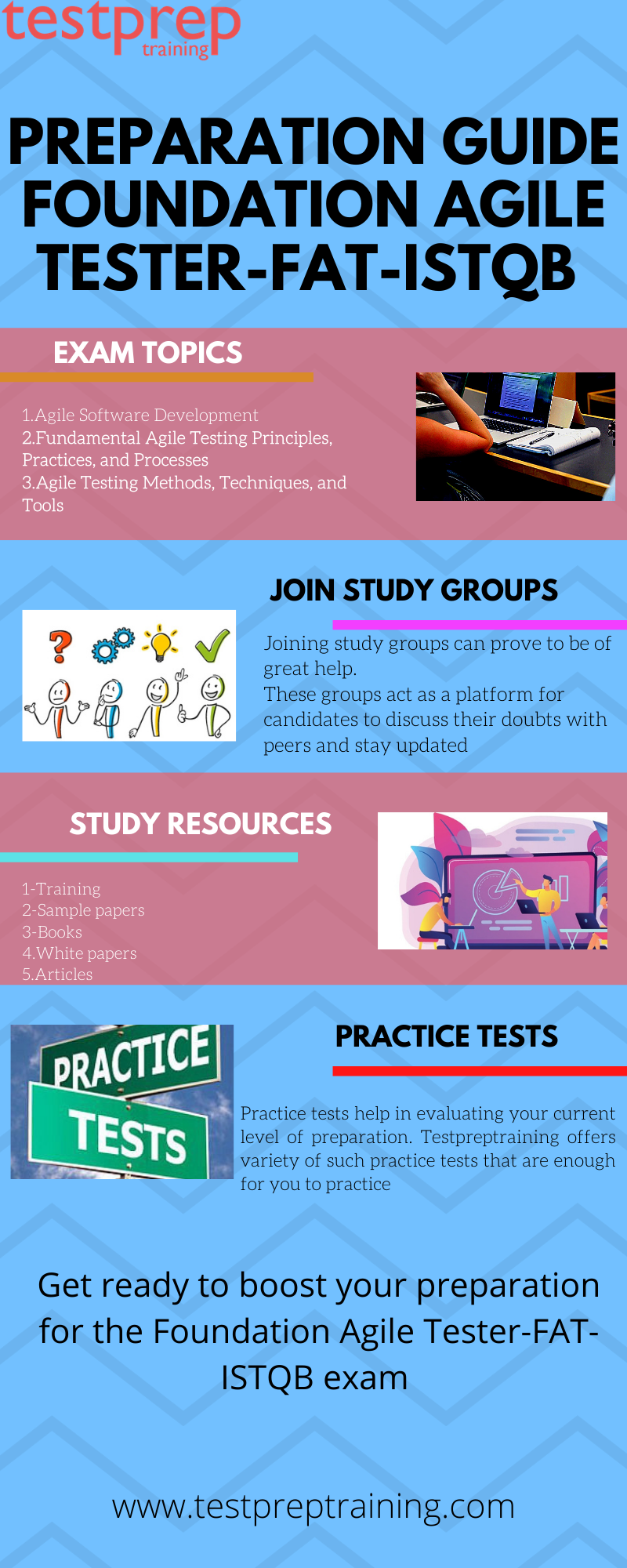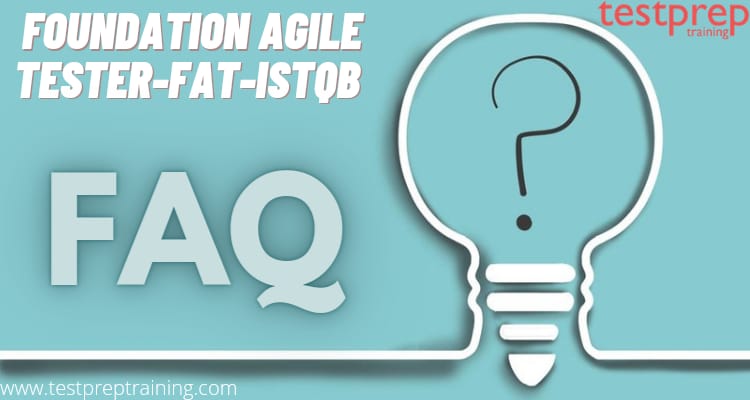Certified Tester Foundation Lever – Agile Tester (CTFL-AT) Interview Questions

The Foundation Agile Tester-FAT-ISTQB certification exam is created specifically for individuals who work in Agile contexts. It’s also for those who want to start using Agile methodologies in the near future or who work for firms that are planning to do so. This certification is for people who wish to learn about the Agile activities, roles, procedures, and approaches that are necessary for their specific position.
Eligibility Criteria
Well, to be eligible to take the Agile Tester Foundation certification exam, one must first pass the ISTQB Foundation Certification exam. After that in order to take the exam, one can find the local exam provider here.
Target Audience
This exam is intended for the following groups of people:
- Professionals who are experienced in traditional methods and want to get the Agile Tester Certificate.
- Junior professionals who are beginning their testing profession and would like to gather knowledge about the tester’s role in an Agile environment.
- People who are relatively new to testing and are required to implement test approaches, methods, and techniques in their job in Agile projects.
- Experienced professionals who require more understanding and knowledge about performing and managing to test on all levels in an Agile environment.
- Anyone who wants an in-depth understanding of software testing in the Agile world, like project managers, quality managers, software development managers, business analysts, IT directors, and management consultants.
Benefits:
Passing the Foundation Agile Tester exam enables the candidate in-
- Collaborating in a cross-functional Agile team with knowledge of principles and fundamental practices of Agile software development.
- Adapting the existing testing experience and skills to Agile values and principles.
- Supporting the Agile team in the planning of test-related activities.
- Applying relevant methods and techniques for testing in Agile projects.
- Assisting the team in test automation activities.
- Assisting business stakeholders in making understandable and testable user stories, requirements, and acceptance criteria as appropriate.
- Working and sharing information with other team members with the use of good communication channels.
Learning Outcomes
The Foundation Agile Tester exam has the following learning objectives-
- The Fundamentals of Agile Software Development
- The different agile approaches
- Agile testing techniques and methods
- Assess product quality risks within an Agile project
- Testing in Agile Projects
- Roles and skills of a tester in Agile Projects
- Estimate testing effort based on iteration content and quality risks
- The Differences between Testing in Traditional and Agile Approaches
- Tools in Agile Projects
Exam Details
| Module | Foundation Level Agile Tester |
| Exam Duration | 60 minutes/ 75 minutes(for those who are not taking exam in their spoken language) |
| Passing Score | 65% |
| Number of Questions | 40 |
| Type of Questions | Multiple-choice type |
For more details and any other queries, visit the Foundation Agile Tester-FAT-ISTQB exam FAQs
Foundation Agile Tester-FAT-ISTQB exam Course Outline
The syllabus for the Foundation Agile Tester-FAT-ISTQB exam has been divided into sections and subsections, given as follows-
1.Agile Software Development
1.1 The Fundamentals of Agile Software Development
1.1.1 Agile Software Development and the Agile Manifesto
1.1.2 Whole-Team Approach
1.1.3 Early and Frequent Feedback
1.2 Aspects of Agile Approaches
1.2.1 Agile Software Development Approaches
1.2.2 Collaborative User Story Creation
1.2.3 Retrospectives
1.2.4 Continuous Integration
1.2.5 Release and Iteration Planning
2.Fundamental Agile Testing Principles, Practices, and Processes
2.1 The Differences between Testing in Traditional and Agile Approaches
2.1.1 Testing and Development Activities
2.1.2 Project Work Products
2.1.3 Test Levels
2.1.4 Testing and Configuration Management
2.1.5 Organizational Options for Independent Testing
2.2 Status of Testing in Agile Projects
2.2.1 Communicating Test Status, Progress, and Product Quality
2.2.2 Managing Regression Risk with Evolving Manual and Automated Test Cases
2.3 Role and Skills of a Tester in an Agile Team
2.3.1 Agile Tester Skills
2.3.2 The Role of a Tester in an Agile Team
3.Agile Testing Methods, Techniques, and Tools
3.1 Agile Testing Methods
3.1.1 Test-Driven Development, Acceptance Test-Driven Development, and Behavior-Driven Development
3.1.2 The Test Pyramid
3.1.3 Testing Quadrants, Test Levels, and Testing Types
3.1.4 The Role of a Tester
3.2 Assessing Quality Risks and Estimating Test Effort
3.2.1 Assessing Quality Risks in Agile Projects
3.2.2 Estimating Testing Effort Based on Content and Risk
3.3 Techniques in Agile Projects
3.3.1 Acceptance Criteria, Adequate Coverage, and Other Information for Testing
3.3.2 Applying Acceptance Test-Driven Development
3.3.3 Functional and Non-Functional Black Box Test Design
3.3.4 Exploratory Testing and Agile Testing
3.4 Tools in Agile Projects
3.4.1 Task Management and Tracking Tools
3.4.2 Communication and Information Sharing Tools
3.4.3 Software Build and Distribution Tools
3.4.4 Configuration Management Tools
3.4.5 Test Design, Implementation, and Execution Tools
3.4.6 Cloud Computing and Virtualization Tools
Foundation Agile Tester-FAT-ISTQB Exam Study Guide
First of all, you should familiarize yourself with all the topics and subtopics that are there in the exam syllabus. As a result, you’ll be able to get a good notion of what you’ll need to learn and how to arrange your learning preparation. Also, bear in mind that the actual application of what you learn is critical, so keep that in mind while you study. So, begin your preparation by thoroughly reviewing the curriculum.

1. Go through the details of exam
The next stage in studying for the exam is to properly review the exam’s contents, including the kind and amount of questions as well as the time given. As a result, this assists you in giving direction to your study as well as analyzing the time given so that you may effectively manage time throughout the exam. So, look over the sample papers and evaluate them thoroughly to ensure that you are familiar with the exam’s format.
2. Study Resources
Consequently, for your convenience, we have compiled the best study resources for your preparation
- If you wish to study from books then this reading is highly recommended: Rex Black, Marie Walsh, Gerry Coleman, Bertrand Cornanguer, Istvan Forgacs, Kari Kakkonen, Jan Sabak (2017), Agile Testing Foundations: An ISTQB Foundation Level Agile Tester guide, BCS, The Chartered Institute for IT, July 2017
- ISTQB provides the following study material in their downloads section-
- White papers(to access Click here)
- Syllabus related articles(to access Click here)
- Glossary
- You can also check out these model papers for a better understanding of the pattern of the exam and the type of questions asked.
- One can also look for training in the ISTQB accredited training providers in one’s local area. You can check the list of training providers from the website of ISTQB.
3. Join study groups
Joining study groups and communities may also be quite beneficial. As a result, this serves as a platform that unites pros and novices, allowing you to have your questions answered while also having beneficial dialogues with people with similar backgrounds. Further, joining these communities keeps you up to date.
4. Practice tests
However, practice questions is the most important aspect of preparation. This aids in the refinement of the information you’ve collected from various study materials. As a result, you can assess your present preparation and enhance your confidence, making the actual exam feel like simply another practice test. There are a variety of practice exams available online, however, the practice tests we provide are quite reliable. They were created by specialists and are sufficient for you to prepare for and pass the test.


